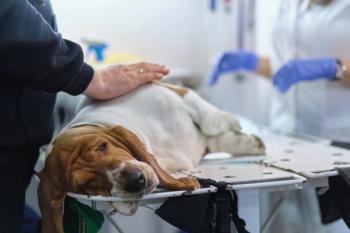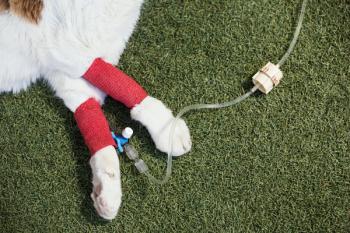
Understanding how the cornea heals offers insights into treatment
The cornea is a unique portion of the outer fibrous tunic of the eye. Being transparent, it is the main refractive structure of the eye due to the air tissue interface. Even though the cornea is constantly exposed to the environment, it is able to maintain its clarity by continually replacing the surface epithelium and by maintaining a preocular tear film with the aid of both the lacrimal system and the eyelids.
The cornea is a unique portion of the outer fibrous tunic of the eye. Being transparent, it is the main refractive structure of the eye due to the air tissue interface. Even though the cornea is constantly exposed to the environment, it is able to maintain its clarity by continually replacing the surface epithelium and by maintaining a preocular tear film with the aid of both the lacrimal system and the eyelids.
In dogs and cats, the cornea is less than 1-mm thick, and the horizontal diameter is approximately 1-mm to 2-mm wider than the vertical diameter. Histologically, four layers are identified: epithelium, stroma, Descemet's membrane and endothelium. The epithelium is the main barrier to penetration of pathogenic organisms or therapeutic agents. The cornea exists in a relatively dehydrated state (deturgescence) through the barrier function of the epithelium and the pump function of the endothelium. Optical clarity is possible due to the maintenance of a regular lattice formation of collagen lamellae by deturgescence, and an absence of blood vessels, pigment or scarring. The cornea is extensively innervated through the ophthalmic branch of the trigeminal nerve making corneal ulcerations exquisitely painful.
Corneal ulcerations represent one of the most common ocular problems in small animal practice. Understanding how the cornea responds to insults is important to knowing how to treat different conditions as well as knowing what to expect in the healing process.
The insult
Damaged corneal epithelium often heals rapidly by a combination of epithelial migration and mitosis. The stroma will heal slower as it has little regenerative capacity. Loss of corneal epithelium (ulcer) will allow fluid to enter the stroma from the tear film creating edema. Corneal edema imparts a bluish-white, honeycomb appearance. Additional pathologic responses include corneal vascularization, pigment migration, lipid or calcium deposition and scarring.
Loss of corneal epithelium as demonstrated by positive fluorescein stain retention constitutes an ulcer (Photo 1). Corneal ulcers are classified by the depth of the corneal involvement: superficial, stromal and descemetocele. Superficial corneal erosions can be classified further as uncomplicated, progressive or indolent. Successful treatment requires identifying and removing the cause of the ulcer, determining the severity of the ulcer, and choosing appropriate therapy. A thorough ocular examination is always indicated with particular attention given to eyelash abnormalities, eyelid structure and function, and tear film disorders (most commonly keratoconjunctivitis sicca).
Photo 1: An example of a traumatic superficial corneal ulceration dorsally with fluorescein stain uptake. Note the subconjunctival hemorrhage.
Considering treatment
Superficial, uncomplicated ulcers are treated with topical antibiotics administered two to three times daily. Topical solutions have the benefit of ease of administration while topical ointments provide longer contact time in cases of dryness or exposure. Topical antibiotics include neomycin-bacitracin-polymyxin, gentamicin sulfate and tetracycline. Topical 1 percent atropine sulfate can be given once to twice daily as well to control discomfort caused by ciliary muscle spasm. Uncomplicated ulcers should heal in two to six days. If they are not healed, re-evaluation is necessary for an underlying, undetected etiology.
Indolent corneal ulcers are so named because they are refractory to conventional medical therapy, require extended treatment times, and need intervention. These ulcers are characterized by a lip of undermined epithelium that is unattached to the stroma or the epithelial basement membrane. Indolent ulcers in dogs are believed to be caused by a defect in the epithelial basement membrane along with a lack of hemidesmosomal attachments. Boxers are perhaps the most common breed affected, although many other dogs are affected similarly. Debridement of these ulcers is mandatory to stimulate healing. The preferred technique is a grid keratotomy performed with a 25-gauge needle under topical anesthesia. Topical 1 percent proparacaine is administered every 30 seconds for a total of five minutes to properly anesthetize the cornea. A sterile swab then can be used to remove all loose epithelium before the crosshatch debridement. The needle is used to make shallow grooves in the anterior stroma in both horizontal and vertical directions. Medical therapy with topical antibiotics (TID) and topical 1 percent atropine sulfate (BID) is continued until healing is complete.
Healing times will commonly be three to four weeks. In some cases, the grid keratotomy may need to be repeated if the healing is incomplete and loose epithelium is still present.
Indolent corneal ulcers in cats have a different etiology than those found in dogs. Most indolent corneal ulcers are caused commonly by an underlying herpesvirus infection. Epithelial keratitis can be characterized by either classic dendritic ulcers, or more commonly, geographic ulcerations with loose edges of epithelium. Diagnosis is usually based upon history and clinical signs as virus isolation and PCR tests are unreliable. In cats, a grid keratotomy is contraindicated as the corneal irritation can either lead to the development of a corneal sequestrum or simply drive the virus deeper into the corneal stroma worsening the keratitis (Photo 2). Therapy consists of topical antibiotics given two to three times daily, topical 1 percent atropine sulfate once to twice daily if painful, oral l-lysine 500-mg twice a day, and a topical antiviral agent such as trifluorothymidine given at least four times daily. L-lysine is a competitive inhibitor of arginine thereby leading to reduced viral replication. Owners should be warned of the protracted nature of herpetic ulcerations as healing times can sometimes be weeks to months in difficult cases. Recurrence of ulcerations is also a possibility as most cats will remain chronically infected.
Photo 2: Large corneal sequestrum centrally surrounded by corneal scarring and neovascularization.
When causes persist
Deep corneal ulcers involve variable amounts of stromal loss with exposure of Descemet's membrane (descemetocele) being the deepest. Complicated deep corneal ulcers occur with persistence of the inciting cause, microbial infection or production of degradative enzymes. Common bacteria isolated from the cornea include Staphylococcus spp., Streptococcus spp., Pseudomonas spp. and Escherichia coli spp. Clinical signs of bacterial keratitis include loss of stroma, severe, diffuse corneal edema, conjunctival hyperemia, stromal inflammatory cell infiltration, neovascularization, exposure of Descemet's membrane and variable degrees of anterior uveitis (Photo 3). Deep stromal ulcers require much more aggressive medical therapy than superficial ulcers and may also require surgery.
Photo 3: Melting corneal ulcer involving the entire stroma. Note the irregularity of the corneal surface secondary to the infection as well as the stromal inflammatory infiltrate.
Antibiotic administration
The frequency of topical antibiotic administration is dictated by the severity of the ulceration. With severe, melting ulcerations, topical antibiotics can, and should, be given as often as every one to two hours during the first several days of treatment. Fluoroquinolone solutions, such as ciprofloxacin and ofloxacin are the antibiotics of choice for corneal infections in dogs and cats. Topical 1 percent atropine sulfate given once or twice daily is usually necessary to control pain. The efficiency of collagenase inhibitors such as acetylcysteine in dogs is questionable. In cases with severe, reflex anterior uveitis oral prednisone 0.25mg/lb once daily is indicated to preserve ocular function. Monitoring of the ulcer every couple of days is essential.
If the ulcer continues to progress or deepen, surgical management must be considered. Descemetoceles are considered a surgical emergency.
When it comes to surgery
Surgical options for the treatment of deep corneal ulcers include conjunctival flaps, conjunctival grafts, corneal scleral transposition and penetrating keratoplasty. Conjunctival flaps are the most common surgical intervention for deep ulcers. They may be considered a type of physiologic bandage by providing both structural support and a vascular supply. Variations of the conjunctival flap include the hood flap, 360-degree flap, bridge flap and pedicle flap. The pedicle flap is the most easily performed and is sufficient in most cases. Conjunctival flaps are left intact for six to eight weeks before being removed. Early diagnosis and intervention can prevent many superficial ulcers from becoming deep complicated ulcers, thereby maintaining vision.
Dr. Ringle received his veterinary degree from the University of Florida in 1989. He completed an internship in large animal medicine and surgery at Illinois Equine Clinic & Hospital and a residency in ophthalmology from Purdue University. He joined Red Bank Veterinary Hospital in 1994.
Michael J. Ringle
Newsletter
From exam room tips to practice management insights, get trusted veterinary news delivered straight to your inbox—subscribe to dvm360.



